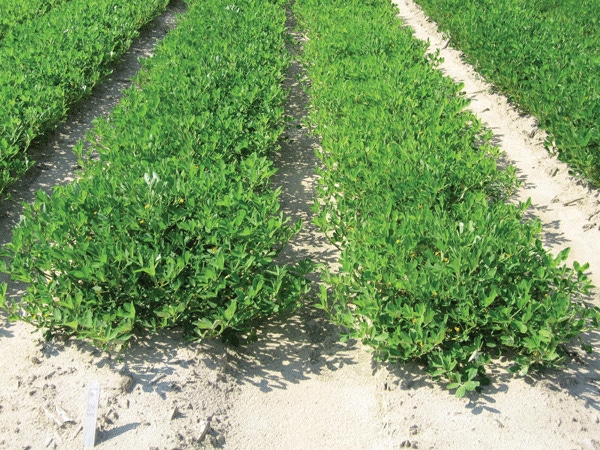
• What’s the true value of a peanut variety’s resistance, from the viewpoint of growers?• Tomato spotted wilt virus (TSWV) resistance certainly matters, and breeders have spent considerable time breeding resistance to other diseases.• In the past five years, many disease-resistant varieties have been phased out because they were not widely adopted.
March 25, 2011

Peanut Rx — an index that allows producers to get the most benefit from their crop management options — assigns a point total to each variety based on its resistance to certain diseases.
But what’s the true value of a variety’s resistance, from the viewpoint of growers?
“How do we integrate these varieties into a peanut disease management program?” asks Bob Kemerait, University of Georgia Extension plant pathologist. “We’ve got a number of different varieties out there now, but my question is, does disease resistance really matter?”
Tomato spotted wilt virus (TSWV) resistance certainly matters, and breeders have spent considerable time breeding resistance to other diseases, he says.
According to Peanut Rx, Georgia Green has 30 points for TSWV and AP-3 has 10, which means that AP-3 has three times as much resistance to TSWV than Georgia Green. And York is five times more resistant to white mold than Georgia Green.
Peanut Rx was developed by researchers at the University of Georgia, Auburn University and the University of Florida and has been endorsed by Syngenta, Nichino, BASF, Bayer CropScience, and Arysta LifeScience.
“A lot of effort went into breeding those varieties, but for whatever reason, the grower community, the sheller community, or the buyers have decided that despite the resistance, the variety was not adopted widely by growers. So growers must be selecting varieties based on something more than just resistance,” says Kemerait.
In the past five years, many disease-resistant varieties have been phased out because they were not widely adopted. “Resistant varieties are being made available to growers, but we don’t keep them,” he says.
Judging from the varieties currently being grown, producers obviously are demanding resistance to TSWV. We have five varieties that are now being grown, and they have different levels of resistance.
In a survey conducted in Miller County, Ga., peanut growers said that white mold, CBR and peanut root-knot nematodes are all severe problems, says Kemerait. Ninety-five percent of the acreage in Miller County this year is expected to be planted in the GA-06G variety.
“This is despite the fact we have Tifguard, which has near immunity to the peanut root-knot nematode. They’ll go with GA-06G and put nematicides underneath them. What’s so special about GA-06G? It has less disease resistance of any of the other varieties that’ll be planted this year. But it’s all about yield potential, which translates into money. Yield potential drives what you’ll plant,” he says.
Growers will adopt varieties that are more resistant to TSWV and CBR, says Kemerait. “You must have resistance to TSWV, and if you have CBR in your fields, you’ll probably choose Georgia Greener or GA-02C over GA-06G.
Investing in yield
Why are growers willing to adopt TSWV and CBR resistance when they hesitate on others? The tools for managing TSWV and CBR are less reliable than tools for managing leafspot and white mold. So you invest in yield, and you say you’ll buy a fungicide program that compensates for the reduction in resistance.”
If you plant a more resistant variety but you treat it exactly the same as a less resistant variety, you’re buying added insurance, he says.
“With Tifguard, we have absolute immunity to the root-knot nematode, and growers are considering instead using Telone or bumping up their rates on Temik and planting GA-06G. You can do that. But by choosing a variety that has to be treated with a nematicide, you are increasing your cost of production anywhere from $30 per acre to $150 per acre simply in the investment of a nematicide. And then you’re assuming that the nematicide will bring up your yield of GA-06G.”
From a research standpoint, it’s a no-brainer between GA-06G and Tifguard if you’ve got nematodes, he says. “From a grower standpoint, there might be concerns over things like peg strength, but if you’ve got nematodes, you owe it to yourself to consider a variety like Tifguard.”
Comparing GA-06G and GA-07W, as far as TSWV resistance, they’re the same, he says, and as far as leafspot resistance, they’re the same.
“But we know that GA-07W has twice the resistance to white mold as GA-06G. This difference is the same as having an extra year of rotation away from peanuts or soybeans. It’s the same as allowing for an earlier planting date without compromising white mold control. This difference negates the effect of a high plant stand, and it negates the impact of tillage and irrigation as far as impact on white mold. That’s the value of something like that. When you look at those differences in the Peanut Rx, that’s what the value is. It’s not just numbers — that’s how you can relate it to what you’re doing.”
With greater resistance now available to growers, the goal of prescription fungicide programs is to make sure you use the right amount of fungicide to maintain yields and maximize profit on return, says Kemerait.
“The variety you select is a key component in what your risk may be. In Georgia, seven spray programs are what we’ve normally been accustomed to. By using this Peanut Rx — by using a good variety, a good rotation, and by choosing resistance, you can go to a low-risk or moderate-risk situation, and in doing so, you can go from a seven-spray program to a five-spray program. Fewer sprays mean less money for fungicides and less cost.”
Improved resistance in varieties should be an important consideration in how growers develop a fungicide program or a disease management program. When you’re deciding between varieties, understand what the benefits are for the resistance program, says Kemerait.
About the Author(s)
You May Also Like



